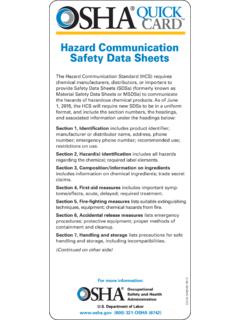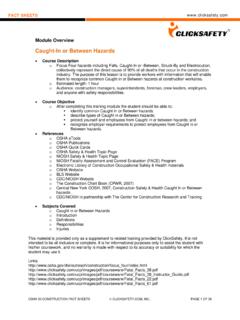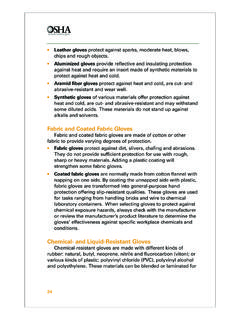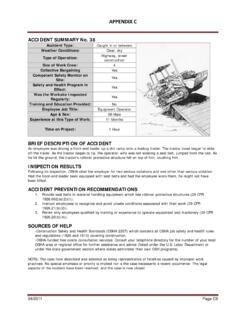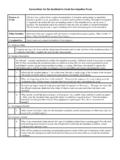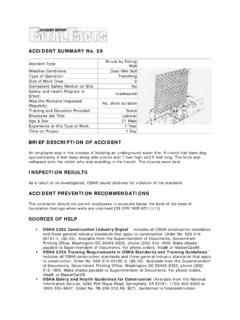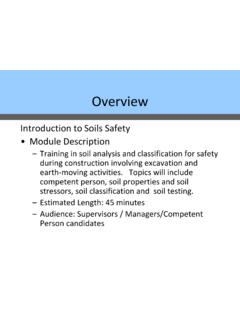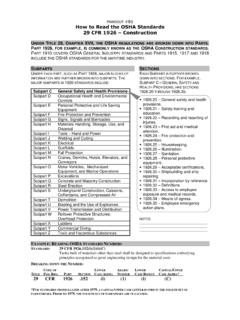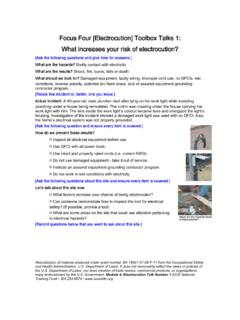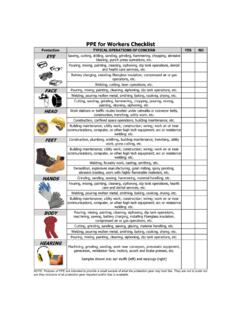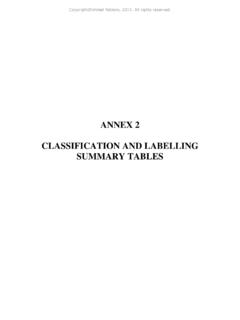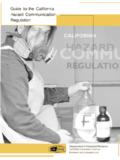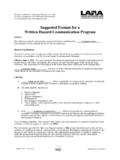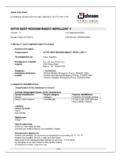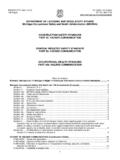Transcription of HAZARD COMMUNICATION DEFINITIONS FROM …
1 HAZARD COMMUNICATION DEFINITIONS FROM 29 CFR, HAZARD COMMUNICATION DEFINITIONS . Article means a manufactured item other than a fluid or particle: (i) which is formed to a specific shape or design during manufacture; (ii) which has end use function(s) dependent in whole or in part upon its shape or design during end use; and (iii) which under normal conditions of use does not release more than very small quantities, , minute or trace amounts of a hazardous chemical (as determined under paragraph (d) of this section), and does not pose a physical HAZARD or health risk to employees. Assistant Secretary means the Assistant Secretary of Labor for Occupational Safety and Health, Department of Labor, or designee. Chemical means any substance, or mixture of substances.
2 Chemical manufacturer means an employer with a workplace where chemical(s) are produced for use or distribution. Chemical name means the scientific designation of a chemical in accordance with the nomenclature system developed by the International Union of Pure and Applied Chemistry (IUPAC) or the Chemical Abstracts Service (CAS) rules of nomenclature, or a name that will clearly identify the chemical for the purpose of conducting a HAZARD classification. Classification means to identify the relevant data regarding the hazards of a chemical; review those data to ascertain the hazards associated with the chemical; and decide whether the chemical will be classified as hazardous according to the definition of hazardous chemical in this section.
3 In addition, classification for health and physical hazards includes the determination of the degree of HAZARD , where appropriate, by comparing the data with the criteria for health and physical hazards . Commercial account means an arrangement whereby a retail distributor sells hazardous chemicals to an employer, generally in large quantities over time and/or at costs that are below the regular retail price. Common name means any designation or identification such as code name, code number, trade name, brand name or generic name used to identify a chemical other than by its chemical name. Container means any bag, barrel, bottle, box, can, cylinder, drum, reaction vessel, storage tank, or the like that contains a hazardous chemical.
4 For purposes of this section, pipes or piping systems, and engines, fuel tanks, or other operating systems in a vehicle, are not considered to be containers. Designated representative means any individual or organization to which an employee gives written authorization to exercise such employee's rights under this section. A recognized or certified collective bargaining agent shall be treated automatically as a designated representative without regard to written employee authorization. Director means the Director, National Institute for Occupational Safety and Health, Department of Health and Human Services, or designee. Distributor means a business, other than a chemical manufacturer or importer, which supplies hazardous chemicals to other distributors or to employers.
5 Employee means a worker who may be exposed to hazardous chemicals under normal operating conditions or in foreseeable emergencies. Workers such as office workers or bank tellers who encounter hazardous chemicals only in non-routine, isolated instances are not covered. Employer means a person engaged in a business where chemicals are either used, distributed, or are produced for use or distribution, including a contractor or subcontractor. Exposure or exposed means that an employee is subjected in the course of employment to a chemical that is a physical or health HAZARD , and includes potential ( accidental or possible) exposure. "Subjected" in terms of health hazards includes any route of entry ( inhalation, ingestion, skin contact or absorption.)
6 Foreseeable emergency means any potential occurrence such as, but not limited to, equipment failure, rupture of containers, or failure of control equipment which could result in an uncontrolled release of a hazardous chemical into the workplace. HAZARD category means the division of criteria within each HAZARD class, , oral acute toxicity and flammable liquids include four HAZARD categories. These categories compare HAZARD severity within a HAZARD class and should not be taken as a comparison of HAZARD categories more generally. HAZARD class means the nature of the physical or health hazards , , flammable solid, carcinogen, oral acute toxicity. HAZARD not otherwise classified (HNOC) means an adverse physical or health effect identified through evaluation of scientific evidence during the classification process that does not meet the specified criteria for the physical and health HAZARD classes addressed in this section.
7 This does not extend coverage to adverse physical and health effects for which there is a HAZARD class addressed in this section, but the effect either falls below the cut-off value/concentration limit of the HAZARD class or is under a GHS HAZARD category that has not been adopted by OSHA ( , acute toxicity Category 5). HAZARD statement means a statement assigned to a HAZARD class and category that describes the nature of the HAZARD (s) of a chemical, including, where appropriate, the degree of HAZARD . Hazardous chemical means any chemical which is classified as a physical HAZARD or a health HAZARD , a simple asphyxiant, combustible dust, pyrophoric gas, or HAZARD not otherwise classified. Health HAZARD means a chemical which is classified as posing one of the following hazardous effects: acute toxicity (any route of exposure); skin corrosion or irritation; serious eye damage or eye irritation; respiratory or skin sensitization; germ cell mutagenicity; carcinogenicity; reproductive toxicity; specific target organ toxicity (single or repeated exposure); or aspiration HAZARD .
8 The criteria for determining whether a chemical is classified as a health HAZARD are detailed in Appendix A to Health HAZARD Criteria. Immediate use means that the hazardous chemical will be under the control of and used only by the person who transfers it from a labeled container and only within the work shift in which it is transferred. Importer means the first business with employees within the Customs Territory of the United States which receives hazardous chemicals produced in other countries for the purpose of supplying them to distributors or employers within the United States. Label means an appropriate group of written, printed or graphic information elements concerning a hazardous chemical that is affixed to, printed on, or attached to the immediate container of a hazardous chemical, or to the outside packaging.
9 Label elements means the specified pictogram, HAZARD statement, signal word and precautionary statement for each HAZARD class and category. Mixture means a combination or a solution composed of two or more substances in which they do not react. Physical HAZARD means a chemical that is classified as posing one of the following hazardous effects: explosive; flammable (gases, aerosols, liquids, or solids); oxidizer (liquid, solid or gas); self-reactive; pyrophoric (liquid or solid); self-heating; organic peroxide; corrosive to metal; gas under pressure; or in contact with water emits flammable gas. See Appendix B to Physical HAZARD Criteria. Pictogram means a composition that may include a symbol plus other graphic elements, such as a border, background pattern, or color, that is intended to convey specific information about the hazards of a chemical.
10 Eight pictograms are designated under this standard for application to a HAZARD category. Precautionary statement means a phrase that describes recommended measures that should be taken to minimize or prevent adverse effects resulting from exposure to a hazardous chemical, or improper storage or handling. Produce means to manufacture, process, formulate, blend, extract, generate, emit, or repackage. Product identifier means the name or number used for a hazardous chemical on a label or in the SDS. It provides a unique means by which the user can identify the chemical. The product identifier used shall permit cross-references to be made among the list of hazardous chemicals required in the written HAZARD COMMUNICATION program, the label and the SDS.
